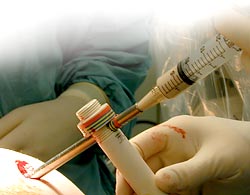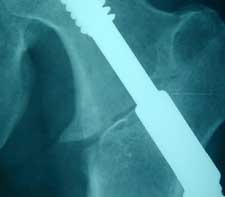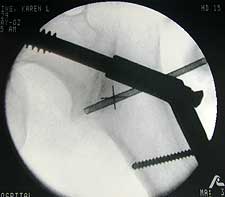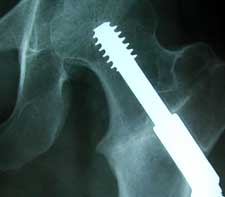Efficacy of DBM products fuels increased use among orthopedists
One expert believes optimal utilization of these low-cost bone graft substitutes stems from appropriate product selection.
|
COURTESY OF ROSS M. WILKINS |
An increasing number of orthopedic surgeons are finding demineralized bone matrix to be a safe and effective substitute for bone graft in procedures like fracture repair, resolution of nonunions, total joint revision surgery and spine fusion. In fact, many practitioners today believe demineralized bone matrix is safer to use than other allograft tissue, frequently turning to it as a biologic solution to their bone-related orthopedic challenges because it contains multiple bone-growth stimulating proteins.
Demineralized bone matrix (DBM) originates from human cadaver bone that undergoes processing with acid to remove most of its mineralized content. This leaves behind the osteoinductive components of the original bone, such as collagen and non-collagen proteins, and growth factors.
As far as safety is concerned, some DBM undergoes subsequent terminal sterilization, according to Ross M. Wilkins, MD, an orthopedic surgeon from Denver. “That’s kind of a differentiating factor, because a lot of the DBM products have not been sterilized or are not sterile,” he said. What’s more, the sterilization processes used, including gamma irradiation and electron or e-beam sterilization, vary among products.
Wilkins has used allograft tissue, including DBM, in hundreds of patients over the years. The DBM he currently uses is e-beam sterilized, which does not affect the growth factor activity.
He told Orthopedics Today he feels most DBM is extremely safe to use, citing the risk of bacterial or viral infection as being very low: less than one in 6 million. None of his patients have developed a bacterial infection related to this material.
Despite this success, he uses an informed patient consent process for all cases involving DBM and said it is imperative “every time I use even 1cc of DBM.” The upside of adhering to so strict a protocol, however, is that it helps his patients better understand the goals of their surgery. As a result, not one of them has ever refused receiving DBM.
More than one available protein
Compared to other products, DBM packs a lot more punch with its multi-protein makeup. For example, compared to the two commercially available bone morphogenetic proteins (BMPs) that contain single proteins, rhBMP-2 and rhBMP-7, “there are at least 25 or 27 [proteins] that have been specifically measured and characterized in human DBM,” said Wilkins, who has researched and worked with DBM and similar products for about 20 years.
|
DBM offers a similar edge over other bone graft substitutes because it contains all the proteins that are naturally occurring in the right proportion in natural bone, he said.
This helps explain why DBM has recently gained popularity, as have other autologous bone substitutes, noted Wilkins, adding that last year, for the first time, the number of orthopedic procedures performed in the United States with bone graft substitutes like DBM exceeded those done with autologous bone graft. “So, more than 50% [of these cases] were not using autograft for bone grafting procedures,” he explained.
DBM use increasing
This increased usage not only signals a trend in bone grafting practices, but also suggests that bone graft substitutes are improving in quality and are becoming more widely accepted, Wilkins told Orthopedics Today in a phone interview.
“There’s no question things are heading that way,” he said, citing fewer complications, shorter hospital stays and better cost effectiveness as key factors associated with increased utilization of all kinds of bone graft substitutes.
And if DBM products are not already leading the way in this area, they soon will be. They are readily available in several forms supplied by both for-profit and not-for-profit organizations.
Wilkins is medical director of one such firm, AlloSource, a non-for-profit bone bank in the Denver area. AlloSource provides the DBM to Wright Medical Technologies for its FDA-approved Allomatrix product and works with other orthopedic firms to meet their needs for DBM-based products.
Selection criteria
|
In order for DBM products to provide the greatest benefit to patients in the full range of orthopedic procedures for which they are indicated, surgeons must be able to select appropriate products, Wilkins said. He urged would-be DBM users “to be aware of what they’re using. Has it been tested? Is it FDA approved?”
According to Wilkins, until just recently, only two DBMs were FDA-approved because approval from the agency was not required. But FDA approval should be required for any DBM combination products since they are defined as medical devices, Wilkins said. Still, FDA approval is good to have because FDA-approved products require thorough testing and terminal sterilization and must meet other key requirements, he added. “Not only does [FDA approval] ensure the quality of the product and the activity, but it shows that the product meets a minimum level of [biologic] activity.”
He suggested asking a DBM supplier how the company’s products are processed to ensure safety and efficacy. Individual donors’ bone should get processed separately rather than having several donors pooled together. Each donor should be fully screened for infectious diseases according to criteria established by the American Association of Tissue Banks. In addition, each batch of DBM should be tested for specific growth factor activities before it is released for distribution.
More bang for the buck
In addition to a multi-protein make-up, Wilkins thinks orthopedists should choose DBM over a single BMP as a bone graft option because it produces better, more mature bone and costs less. “There are dozens and dozens of proteins that are necessary for bone healing and, perhaps more importantly, for bone remodeling. You can get a single protein to make a bone mass of immature bone, but you need that bone to remodel and turn into cortical bone. You need multiple proteins for that,” he said.
In addition, new bone produced by DBM tends to be more normal in shape and size. Research comparing DBM and BMP bone production has confirmed that, Wilkins said. “Generally, people who use DBM prefer it because it’s got all of the proteins that are necessary, more than just a single protein. The second reason is it’s also a lot less expensive.”
The price of DBM products makes them extremely attractive in today’s health care environment, which encourages cost savings. So although the recombinant human BMP-2 and BMP-7 products have received various FDA approvals and have proved in controlled clinical studies to be at least equivalent to autograft in a few applications, their high price tag drives up the cost of every procedure in which they are used.
DBMs, on the other hand, tend to be more economical. “It’s hard to justify $5000 to $6000 a dose for a graft that is no better than autograft and no better than DBM,” Wilkins said of BMPs. By comparison, DBM sold in the United States ranges in price from about $100 to $300 for 1cc.
|
Accelerated fracture healing
One potential new application involving surgical implantation of DBM products involves placing them at the site of fresh fractures. “Now we are grafting all acute fractures to see if we can speed up healing,” Wilkins said, describing the procedure he and his colleagues at Colorado Limb Consultants have used for the past two years.
Biologically and in terms of quicker return to function, this makes sense, he said.
“It supercharges the bone healing process and these patients are getting back to work early. I think that’s the future of these materials,” he said.
“We’re not there yet, but I think the real excitement and the future of all these growth factors is that we’re going to be able to speed up fracture healing. So, if somebody breaks their leg, instead of being out of work three months, they’re out of work a month. Imagine the savings and the economic benefit. That’s really the excitement of all this bone-healing work.”
Dr. Wilkins is a paid consultant for a company mentioned in the article.





